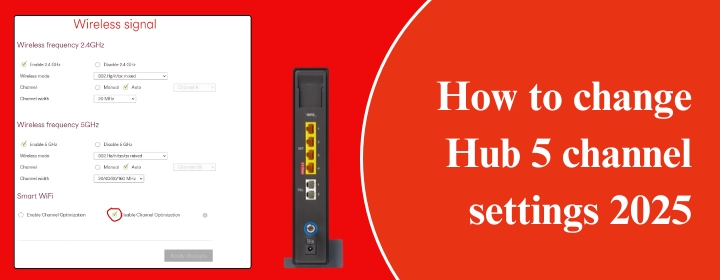
How to change Hub 5 channel settings 2025
Fighting sluggish Wi-Fi or unexpected signal drops? Within minutes of adjusting the Wifi channel settings on your Hub 5 can fix it. There is this procedure: Launch a browser, input IP address “192.168.1.1,” log in using your router credentials, then go Advanced Settings > Wireless > Channel Selection. From there, carefully choose a less busy channel—especially for the 2.4GHz or 5GHz band—to rapidly improve performance.
Although routers generally auto-select channels, in a neighborhood full of competing signals the “auto” option doesn’t always get it correctly. Selecting a less noisy connection manually speeds things up, stabilizes your connection, and helps to lower interference.
Whether you’re working from home, gaming, or streaming, this tutorial will help you clearly, step by step, with no confusion. Let’s start immediately; if you want a better connection right now!
Why Channel Settings Matter
WiFi works across specific frequencies: mainly 2.4GHz and 5GHz. Each frequency has multiple “channels” your devices can use. Think of them like radio stations. If too many devices are using the same channel (or overlapping ones), signals get noisy, and performance drops. This is especially true with older or cheaper devices that don’t switch channels efficiently.
The Hub 5, like most routers, automatically selects what it thinks is the “best” channel.
Step-by-Step: How to Change WiFi Channel on Virgin Hub 5
Connect to the Hub
Make sure your gadget connects via WiFi or via ethernet to your home network. Open a browser then visit: “192.168.0.1”.
This is the default IP address for the Virgin Hub 5 admin interface.
Login
You’ll see a login screen. By default, your password is printed on the sticker on the bottom or back of your router. After the successful login, you’ll reach the router’s dashboard.
Navigate to WiFi Settings
Navigate to “Advanced Settings” and select “Wireless.” Generally, there are the separate options for the 2.4GHz and 5GHz bands.
Disable Automatic Channel Selection
For both frequency bands, disable the option that says “Auto” or “Smart WiFi Channel.” This allows you to choose a fixed channel manually.
Select a Channel
Now comes the tuning part:
- For 2.4GHz choose either channel 1, 6, or 11. These are less likely to cross over and non-overlapping.
- In home contexts most reliable for 5GHz are channels 36, 40, 44, and 48.
To find which performs best for your system, you will have to play around a bit.
Apply and Save
Once you’ve selected a new channel, scroll down and click “Apply” or “Save Settings.” The Hub may briefly restart its wireless radios. Wait for all devices to reconnect.
How to Test If It’s Working
After changing channels, monitor your network. You will see one or more of the following improvements:
- More consistent speeds throughout the day.
- Fewer dropouts on smart TVs, gaming consoles, or laptops.
- Improved signal range on one or both bands.
It won’t happen immediately. Give it a bit of time. If things don’t improve, try another channel or check for interference from nearby electronics like baby monitors, microwave ovens, or other routers.
Pro Tips for Hub 5 Channel Optimization
- Use a WiFi analyzer app. These tools scan your surroundings and show which channels are crowded. They’re extremely helpful if you’re in an apartment or city area with lots of competing networks.
- Keep firmware up to date. Virgin occasionally updates the Hub’s software automatically, but it’s good practice to check manually every few months through the admin panel.
- Split your SSIDs. If you’re at ease with sophisticated settings, think about splitting the 2.4GHz and 5GHz bands under distinct network names. This gives you more control over which devices connect to which band.
- Avoid DFS channels on 5GHz unless you understand what they do. Although DFS (Dynamic Frequency Selection) may be more rapid channels, they may also cause brief signal loss and are vulnerable to radar interference.
FAQs
No. Your devices will automatically reconnect after the Hub reboots the radio. You won’t need to re-enter passwords.
If your Hub is in “Intelligent WiFi” mode, it might override your manual settings. You may need to disable this feature in the advanced settings.
No. What works best depends entirely on your environment. That’s why using a WiFi analyzer can help narrow down the least-congested channels.
As of early 2025, no. You still need to log in via browser to access manual channel settings. The app mostly supports rebooting and checking status.
Make sure you’re typing the correct IP: 192.168.0.1. If that doesn’t work, try 192.168.100.1 or check your device’s gateway IP in the network settings.
Yes, in most cases. But if you’re running 30+ connected devices, smart plugs, lights, speakers, and cameras—consider pairing the Hub with a dedicated router in modem mode for better performance and control.
Final Thoughts
Changing your Virgin Hub 5 channel settings isn’t just a tech trick—it’s a solid way to take control of your wireless network in a world that’s only getting more crowded with devices. In 2025, with smart homes becoming the norm, relying on automatic settings just doesn’t cut it anymore.
Log in, test different channels, and keep track of what works. A few tweaks can make a big difference in speed and stability. It’s worth the time. And once you’ve got it dialed in, your WiFi will work hassle free!
